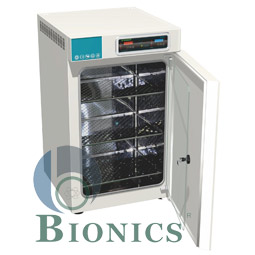Optimal Culturing in a Compact Space: Unveiling the Mini CO2 Incubator (Midi) 42 Liters
In the realm of cell culture and laboratory research, creating the perfect environment for cells to thrive is paramount. The Mini CO2 Incubator (Midi) 42 Liters emerges as a compact yet powerful solution, offering researchers the ability to cultivate cells with precision in a limited space.
Mini CO2 Incubator: A Glimpse into Efficiency
1. Compact Footprint, Maximum Impact
Measuring at 42 Liters, the Mini CO2 Incubator (Midi) is designed to fit seamlessly into laboratories where space is a premium. Despite its compact footprint, this incubator doesn't compromise on performance, providing a controlled environment for cell cultures.
2. Precise CO2 Control
Maintaining the right carbon dioxide (CO2) levels is crucial for cell growth, and the Mini CO2 Incubator ensures precise control. With user-friendly interfaces and advanced CO2 regulation systems, researchers can create an optimal environment for their cultures.
Applications Across Research Domains
1. Cell Biology Advancements
In cell biology research, the Mini CO2 Incubator plays a pivotal role in advancing our understanding of cellular processes. Researchers can create customized environments for different cell types, enabling the study of cell behavior under specific conditions.
2. Tissue Engineering Breakthroughs
For tissue engineering projects, where the creation of artificial tissues is a delicate process, the controlled environment provided by the Mini CO2 Incubator is indispensable. It facilitates the growth of cells into functional tissues with precision.
3. Pharmaceutical Development
In pharmaceutical research, especially in drug discovery and development, the Mini CO2 Incubator aids in culturing cells for testing drug efficacy and toxicity. The controlled conditions ensure reliable and reproducible results in these critical stages of drug development.
Key Features and User-Friendly Design
1. Temperature Uniformity
The Mini CO2 Incubator is engineered for temperature uniformity, ensuring that every corner of the chamber provides the same ideal conditions for cell growth. This feature is vital for maintaining the consistency and reliability of experimental results.
2. Intuitive Controls
With a user-friendly interface, the Mini CO2 Incubator allows researchers to set and monitor conditions with ease. Intuitive controls contribute to a seamless workflow, making it an ideal choice for researchers at all levels of expertise.
3. Durability and Reliability
Crafted with durability in mind, the Mini CO2 Incubator is built to withstand the rigors of continuous use. Researchers can rely on its consistent performance, ensuring the longevity of their experiments.
Conclusion: Cultivating Success in a Small Package
In the dynamic landscape of laboratory research, the Mini CO2 Incubator (Midi) 42 Liters stands out as a powerful tool for achieving precise and controlled cell cultures. Its compact design, coupled with advanced features, makes it a valuable asset for researchers aiming to optimize their laboratory space without compromising on experimental integrity. As science continues to push boundaries, this mini incubator proves that size is no limitation when it comes to cultivating success in cellular research.
#laboratory equipment manufacturer, #laboratory equipment manufacturers in india

Comments
Post a Comment